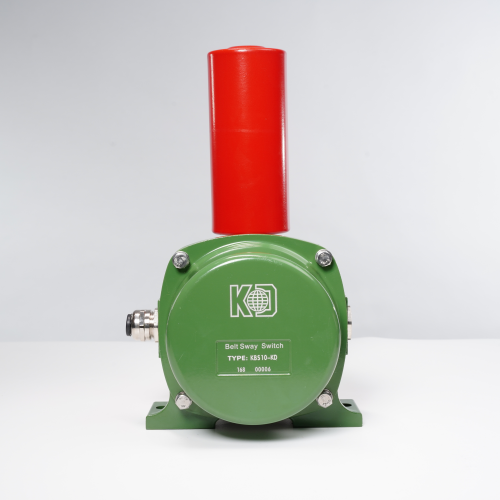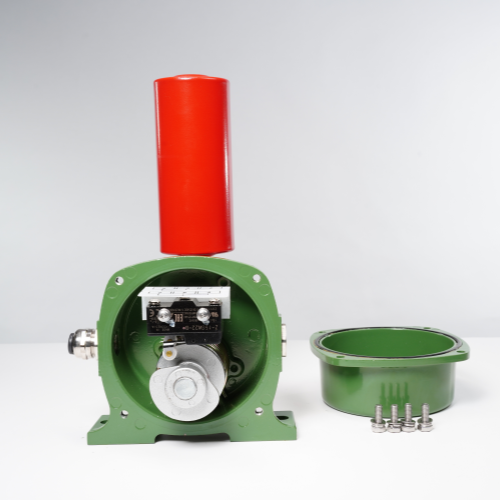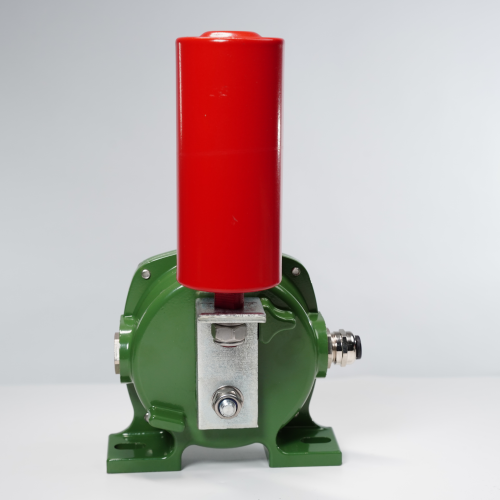BETTER TOUCH BETTER BUSINESS
Contact Sales at KAIDI.
We all know that in the conveyor system, the running condition of the belt conveyor is directly related to the production process of equipment and personnel safety.
So how to make the belt conveyor protection devices stable and reliable in production operation to give full play to the role of safety protection, has a very important practical significance conveyor in operation is easy to run off and skidding is a common problem in the use of the process of the user, these problems are very easy to cause the conveyor belt breaks and other faults and even affect the safety of the personnel, therefore, in the conveyor to install these protection devices is extremely necessary, common to prevent the conveyor run off and skidding devices are two kinds: run off switch and skidding switch, here to prevent the conveyor and skidding switch. Conveyor deflection and skidding device has two kinds: deflection switch and skidding switch, here we were on its selection and installation to explain, as well as some of the matters to be noted summed up to facilitate the user to understand and choose.

The deflection switch is a protection device used to detect the degree of conveyor belt deflection during the operation of belt conveyor and give an alarm, and is also used to trigger an emergency stop automatically when the belt is seriously deflected. The deflection switch is fixedly mounted on the supports on both sides of the belt conveyor at certain intervals (about 50m). The roller part of the deflection switch is deflected after being squeezed by the edge of the off-centre conveyor belt, and triggers the switch contact action when the roller is deflected to a certain angle.

Installation Methods and Precautions:
(1) Select a reasonable installation distance. Belt deflection occurs mostly at the head and tail ends, so the deflection switch should be installed within 15m from the head and tail of the conveyor, and the installation distance of the deflection switch in the middle of the belt conveyor safety devices should be controlled within 50m as far as possible.
(2) According to the process requirements of conveyor equipment, choose a reasonable range of deflection. Generally, the belt deflection displacement is not allowed to exceed 1/5 of the width of the belt, and the belt deflection is not allowed to touch the side of the fixed mechanism, and the deflection range of the head and tail ends of the belt is allowed to be controlled at least in the support mechanism on both sides of the rolling brief.
(3) The mounting bracket of the deflection switch should be made into a structure that can adjust the position of the deflection switch along the side of the belt. This is to adjust the permissible runaway range in a small range according to the actual situation on site.
Slipping switch is a protection device used to detect the slipping between the conveyor belt and the drive pulley and give an alarm, which can be used to trigger an emergency stop automatically when the belt conveyor slips. There are many types of slip switches with different working principles and detection methods. For example, according to the detection method, there is a direct detection of conveyor speed and set the standard speed comparison of the touch wheel slip switch, there is a detection of the slave wheel speed and set the standard speed comparison of the slip switch, at the same time, respectively, detection of roller speed and conveyor speed and comparison of comparison slip switch; according to the internal principle of work, there is a magneto-resistive, magnetoelectric, photosensitive and so on. Many slip switch devices can also provide real-time conveyor belt speed or roller speed signal display and output.
Choose the appropriate mounting method according to different product types. The non-contact slip switch should be installed as far away as possible from strong electromagnetic field interference and covered with a metal cover. The slip alarm value should be set after on-site measurement. The speed parameter of each stainless steel belt conveyor is generally not the same as the actual belt running speed is also affected by the installation method of conveyor and its structure, so it is necessary to set the alarm value of the action of the slip switch of each conveyor one by one.
Through the installation of belt conveyor running switch and slip switch these two protection devices, can effectively reduce the chances of conveyor failure to reduce the failure of downtime, but also better protection of conveyor equipment and personnel safety.

Selection principles and considerations:
(1) Try to choose two-stage or multi-stage deflection switch, which can detect different deflection degree of the belt and provide more information for the control system.
(2) Priority to choose the switch body with action memory and action status indication products. Because the belt conveyor is dynamic operation, with this function can be convenient to determine the specific position of the belt deflection, analyse the cause of deflection, but also to facilitate the debugging and maintenance of equipment.
(3)You can choose non-contact deflection switch if you have the condition. Non-contact deflection switch to make photoelectric proximity switch instead of the roller to detect whether the belt deflection its advantages are long life, easy to maintain, the disadvantage is that the price is expensive.
The measuring range should be selected according to the actual speed of the stainless steel belt conveyor to be tested. Usually, the belt running line speed during normal operation is about 2.5-4m/s, and the speed of the roller is about 50-300rpm. besides the comparative slip switch which detects the speed of the roller and the speed of the conveyor belt at the same time and compares them, it is preferable to choose the product which can automatically avoid the low speed state during the start-up of the belt conveyor. As the slip alarm of the coal conveyor belt is actually a low-speed alarm, the slip alarm should be shielded during the start-up of the conveyor, and the method of delayed detection during the start-up of the conveyor can be adopted (i.e., the start-up is delayed for a certain period of time after the start-up, and the slip switch is connected to the power supply when the belt conveyor reaches the normal rotational speed), but the realisation of this is quite troublesome.
Some products can automatically avoid the low-speed state when the conveyor starts: the conveyor starts at the same time as the slip switch power supply, slip switch gets power to work after a period of time delay before the normal detection of belt speed. Try to choose the product with actual speed display and remote transmission of speed signal.
We are here to help you! If you close the chatbox, you will automatically receive a response from us via email. Please be sure to leave your contact details so that we can better assist